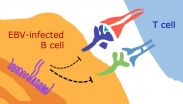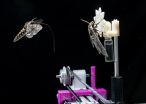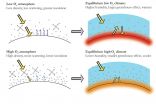New study links excessive iron in cells with AMD, other diseases
2015-06-11
(Press-News.org) LEXINGTON, Ky., June 12 -- In a new University of Kentucky study published today in Cell Reports, a leading scientific journal in cell biology, researchers describe a new molecular mechanism that contributes to age-related macular degeneration (AMD) due to accumulation of excessive iron within the cells of the retina.
Cells of the body use iron in dozens of normal metabolic processes. However, excessive iron or 'iron overload' can be very damaging to cells and tissues, and is implicated in numerous diseases, including AMD.
'The reason that cells die due to iron overload is not fully understood,' said Bradley Gelfand, assistant professor in the Department of Ophthalmology and Visual Sciences at the UK College of Medicine and lead author on the study. 'Our study found that iron overload induces retinal cell death by activating an inflammatory signaling pathway called the inflammasome. This occurs because iron specifically impairs the ability of retinal cells to process inflammatory RNAs called Alu RNAs. In the presence of iron overload, these RNAs build up and cause inflammasome-mediated cell death.'
Iron overload is most commonly associated with diseases like thalassemia and hemochromatosis. The liver is the most commonly associated target of iron overload. These diseases are due to systemic (i.e. whole body) overload of iron. Other diseases such as AMD, Parkinson's and Alzheimer's are associated with 'local' iron overload in which excess iron has been measured specifically in the area of release.
Implications for the study are that treatments previously targeted specifically to prevent inflammatory processes in AMD, may also prevent toxicity due to iron overload which is also thought to contribute to disease, but was previously thought to be separate.
INFORMATION:
ELSE PRESS RELEASES FROM THIS DATE:
2015-06-11
About 90% of adults worldwide are infected with Epstein-Barr virus, or EBV. The virus infects B cells (the white blood cells that make antibodies) and can contribute to B-cell-derived cancers, but in most people it remains dormant--a state scientists refer to as "latent infection"--for the rest of their lives. A study published on June 11th in PLOS Pathogens sheds new light on why the infected person's immune system cannot eliminate EBV, or the associated cancer risk.
Interested in the immune response against EBV, Andreas Moosmann, from the Helmholtz-Zentrum in Munich, ...
2015-06-11
It's difficult enough to see things in the dark, but what if you also had to hover in mid-air while tracking a flower moving in the wind? That's the challenge the hummingbird-sized hawkmoth (Manduca sexta) must overcome while feeding on the nectar of its favorite flowers.
Using high-speed infrared cameras and 3-D-printed robotic flowers, scientists have now learned how this insect juggles these complex sensing and control challenges - all while adjusting to changing light conditions. The work shows that the creatures can slow their brains to improve vision under low-light ...
2015-06-11
ANN ARBOR--Variations in the amount of oxygen in Earth's atmosphere significantly altered global climate throughout the planet's history. Efforts to reconstruct past climates must include this previously overlooked factor, a new University of Michigan-led study concludes.
Oxygen currently comprises about 21 percent of Earth's atmosphere by volume but has varied between 10 percent and 35 percent over the past 541 million years.
In periods when oxygen levels declined, the resulting drop in atmospheric density led to increased surface evaporation, which in turn led to ...
2015-06-11
This news release is available in Japanese.
Water injected into an inactive fault can cause aseismic slip along the fault -- movement without detectable earthquakes -- that may then indirectly lead to micro-earthquakes. That's the result from a controlled experiment by Yves Guglielmi and colleagues, who observed these events in real time after injecting fluid into a natural fault near an underground experimental facility in southeastern France. Researchers are intensely interested in this type of induced seismicity, especially with a rise in earthquakes caused by ...
2015-06-11
This news release is available in Japanese. New experiments in the Japanese rice fish show that the fox13 gene appears to be the switch that determines whether a germ cell becomes an egg or sperm cell. The finding could help researchers learn more about how the sexual fate of germ cells is determined during vertebrate development. Toshiya Nishimura and colleagues demonstrated that fox13, which is expressed in germ cells but not in the surrounding cells of the fish's reproductive organs, provides a molecular cue that prevents the start of sperm formation. When the researchers ...
2015-06-11
This news release is available in Japanese.
Variations in the percentage of atmospheric oxygen may have influenced climate in the past 500 million years, according to new calculations by Christopher Poulsen and colleagues. Since oxygen isn't a greenhouse gas like carbon dioxide, it typically hasn't been included in studies of past climate change. But the proportion of atmospheric oxygen has varied between 10 percent and 35 percent over the past 500 million years, and Poulsen and colleagues have developed a model to show how those fluctuations might impact climate. ...
2015-06-11
This news release is available in Japanese.
How do nocturnal insects forage so successfully in the twilight and darkness? A new study by Simon Sponberg and colleagues suggests that the vision of the hawkmoth, Manduca sexta, which hovers in place while it feeds on nectar at dawn and dusk, is finely attuned to the swaying of flowers in the breeze. These findings imply that both the sight and flight of the hawkmoth likely evolved to match the movements of flowers -- their only source of food -- perfectly, helping to explain how the nimble insects are able ...
2015-06-11
A new study by researchers at the Stanford University School of Medicine found that synchronized physiological interactions between remote brain regions have genetic underpinnings.
The research was performed at Stanford but was made possible by collaborations with the Seattle-based Allen Institute for Brain Science and the IMAGEN Consortium, a multicenter European project, said the study's senior author, Michael Greicius, M.D., an associate professor of neurology and neurological sciences.
The study will be published June 11 in Science.
An emerging consensus among ...
2015-06-11
This news release is available in German.
It has been hypothesized that globalization of human-mediated dispersal of species may break down biogeographic boundaries. However, empirical tests had been lacking until recently. An international research team has now discovered a comprehensive biogeographic reorganization for 175 species of alien gastropods across 56 countries. The data shows that homogenization is indeed happening. Geographic barriers to dispersal have fallen down but climate still limits how species colonize new areas. The study was published in the ...
2015-06-11
Investigators from Massachusetts General Hospital (MGH) and the Ragon Institute of MGH, MIT and Harvard have added another piece to the puzzle of how a small group of individuals known as elite controllers are able to control HIV infection without drug treatment. In their paper published in the open-access journal PLOS Pathogens, the research team reports finding that dendritic cells of elite controllers are better able to detect the presence of HIV - paradoxically through a greater susceptibility to HIV infection - which enables them to stimulate the generation of T cells ...
LAST 30 PRESS RELEASES:
[Press-News.org] New study links excessive iron in cells with AMD, other diseases



